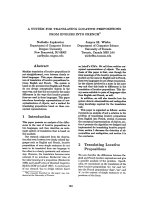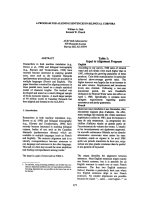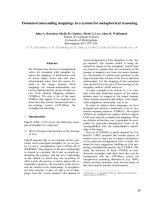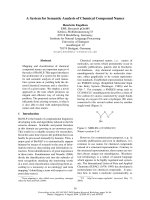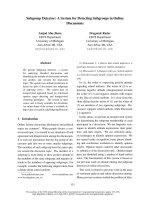a system for managing experiments in data mining
Bạn đang xem bản rút gọn của tài liệu. Xem và tải ngay bản đầy đủ của tài liệu tại đây (1.26 MB, 64 trang )
A System for Managing Experiments in Data Mining
A Thesis
Presented to
The Graduate Faculty of The University of Akron
In Partial Fulfillment
of the Requirements for the Degree
Master of Science
Greeshma Myneni
August, 2010
ii
A System for Managing Experiments in Data Mining
Greeshma Myneni
Thesis
Accepted: Approved:
______________________________ _____________________________
Advisor Dean of the College
Dr. Chien-Chung Chan Dr. Chand Midha
______________________________ _____________________________
Committee Member Dean of the Graduate School
Dr. Kathy J. Liszka Dr. George R. Newkome
______________________________ _____________________________
Committee Member Date
Dr. Yingcai Xiao
______________________________
Department Chair
Dr. Chien-Chung Chan
iii
ABSTRACT
Data Mining is the process of extracting patterns from data. There are many
methods in Data Mining but our research mainly focuses on the classification methods.
We present the existing data mining systems that are available and the missing features in
those systems. An experiment in our research refers to a data mining task. In this research
we present a system that manages data mining tasks. This research provides various
advantages of managing the data mining tasks. The system to be dealt with in our
research is the “Rule-based Data Mining System”. We present all the existing features in
the Rule-based Data Mining System, and show how the features are redesigned to
manage the data mining tasks in the system. Some of the new features are managing the
datasets accordingly with respective to the data mining task, recording the detail of every
experiment held, giving a consolidated view of experiments held and providing a feature
to retrieve any experiment with respect to a data mining task . After that we discuss the
design and implementation of the system in detail. We present also the results obtained
by using this system and the advantages of the new features. Finally all the features in the
system are demonstrated with a suitable example. The main contribution of this thesis is
to provide a management feature for a data mining system.
iv
TABLE OF CONTENTS
Page
LIST OF FIGURES vii
CHAPTER
I. INTRODUCTION …
1
1.1 Machine Learning …………… 1
1.1.1 Learning Strategies 1
1.1.2 Inputs and Outputs…… 2
1.1.3 Testing……………………… 4
1.2 Tools………………………… 5
1.2.1 WEKA 5
1.3 Observations 6
1.4 Proposed Work……………………………………………………
7
1.5 Organization of the Thesis……………………………………… 8
II. FEATURES OF EXPERIMENT MANAGEMENT SYSTEM …… 9
2.1 Introduction… 9
2.1.1 Upload……………………………………………………. 10
2.1.2 Learn 10
2.1.3 Test 11
v
2.1.4 Learn and Test 11
2.2 Experiment Management System………………………………. 12
2.2.1 Upload 12
2.2.2 Learn
12
2.2.3 Generate Test File 13
2.2.4 Test 13
2.2.5 Learn and Test 13
2.2.6 Experiments 14
III. DESIGN…………………………………… 15
3.1 ER Model………………………… 15
3.2 Database Design……………………………… ………………
17
3.2.1 Tables…………………………………………… 20
3.2.2 Relationships………………………………………… 21
IV. IMPLEMENTATION 23
4.1 System Input 23
4.1.1 Upload………………………………………………… 24
4.2 System Output
26
4.2.1 Learn…………………………………………………
26
4.2.2 Generate Test File……………………….……………… 27
4.2.3 Test…………………………………………………… 28
4.2.4 Learn and Test…………………………………… … 29
4.2.5 Experiment………………………………………… 31
V RUNNING EXAMPLE………………………………………………….…. 37
vi
VI DISCUSSIONS AND FUTURE WORK……………………………………
46
6.1 Contributions and Evaluations…… 46
6.2 Future Work………………………………………………… 47
REFERENCES……………………………………………………………………. 48
APPENDICES……………………………………………………………… 50
APPENDIX A Source Code for Writing Files to Database……………….
51
APPENDIX B Source Code for Writing Details of Experiment to
Database……………………………………………
54
vii
LIST OF FIGURES
Figure Page
1.1 Decision Tree for Playing Tennis………………………………………… 3
1.2
ng
Rules of Decision Tree for Playing Tennis………………………………… 4
3.1 ER Diagram……………………………………………………………… 17
3.2
Database Design for Managing Experiments …………………………….
19
4.1 Sample Attribute File…….………………………………………………… 23
4.2 Sample Data File…………………… ……………………………………. 24
4.3 Upload Snapshot…………………………… 25
4.4 Learn Snapshot……………
26
4.5 Generate Test File Snapshot……………………………………………… 28
4.6 Test Snapshot…
29
4.7 Learn and Test Snapshot……… 30
4.8 Experiment Snapshot…………………………
……
32
5.1 Attribute File for Bench Dataset…………………………………………… 37
5.2 Data File for Bench Dataset……………………………………………… 38
5.3 Experiment Snapshot after Upload of Dataset…………………………… 39
5.4 Experiment Snapshot after Learning………………………………………. 40
5.5 Experiment Snapshot after Generating a Test file…………………………. 41
viii
5.6 Experiment Snapshot after Testing………………………………………… 42
5.7 Experiment Snapshot after Learning and Testing…………………………
43
5.8 Snapshot of First Ten Experiments……………………………………… 44
5.9 Snapshot of Next Ten Experiments……………………………………… 45
1
CHAPTER I
INTRODUCTION
1.1 Machine Learning
Learning is important for practical applications of artificial intelligence.
According to Herbert Simon [1], learning is defined as “any change in the system that
allows it to perform better the second time on repetition of the same task or on another
task drawn from the same population”. The main objective of machine learning methods
is to extract relationships or patterns, hidden among large pile of data. The most popular
machine learning method is learning from example data or past experience. The example
data is also called as training data. Machine learning has many successful applications in
fraud detection, robotics, medical diagnosis, search engines etc [1, 2].
1.1.1 Learning Strategies
There are two main categories in machine learning: supervised learning and
unsupervised learning. Classified training data has a decision attribute along with
condition attributes. The supervised learning classifier generates rules, using the
classified training data [2]. The rule is a simple model that explains the data and fits the
entire data.
2
In unsupervised learning, the data is not classified. The main objective of this
learning is to find the patterns in the input [2]. One form of unsupervised learning is
clustering, where the aim is to group (cluster) the input data. There are many other types
of machine learning, which can be referred from [5, 3].
1.1.2 Inputs and Outputs
In this thesis, we are mainly interested in supervised learning. The input given to
the classifier is classified training data. The training data is composed of input and output
vectors. The input vector is characterized by a finite set of attributes, features,
components [2]. The output vector is also called a label, or a class, or a category or a
decision. The input and output vectors can be of real valued numbers, discrete valued
numbers and categorical values, which are finite sets of values. The training data may be
reliable or may contain noise [5]. Data with missing values complicates the learning
process. Hence before input is given to the machine learning system preprocessing is
needed. Data pre-processing [4] includes cleaning, normalization, transformation, feature
extraction and selection. Typical input to the learning system can be a text file containing
all training examples. In general, the input has two files namely data file and attribute
file.
When the input is given to the learning system, the learning algorithm generates
the rule set. The rule set generated might not be perfectly consistent with all the data, but
it is desirable to find a rule set that makes as few mistakes as possible. The representation
of learned knowledge varies with the learning system. Figure 1.1 gives the representation
of learning in a decision tree.
3
In decision tree learning [6], the representation of the learned knowledge is
represented using decision trees. The classifications are represented by the leaf nodes.
The collections of features that derive to these classifications are represented by
branches. An unknown type is classified by traversing the entire tree and taking
appropriate branch. This continues until a leaf node is reached.
Figure 1.1 shows an example of decision tree for play tennis. In Figure 1.1[5, 9],
the classifications are yes and no. The internal node indicates the property and branches
test the individual value for that property.
Figure 1.1 Decision Tree for Playing Tennis
From the decision tree in Figure 1.1 we can generate rules as shown in Figure 1.2 [5, 9]
4
Figure 1.2 Rules of Decision Tree for Playing Tennis
1.1.3 Testing
Testing helps to validate the learned knowledge, and calculate the performance of
the classifier. There are many testing strategies applied in order to validate. Some of the
popular testing strategies are sub sampling and N-fold Cross Validation [9].
In the sub sampling method, the dataset is split into training data and validation
data. For each split, the training is done on training data and tested across the validation
data. The results are then averaged over the splits. The main disadvantage of this method
is some observations may not be selected or some observations may be selected more
than once. In other words, validation subsamples may be overlapped.
The other common method type for testing is N-Cross Validation. In N-Cross
Validation, the dataset is partitioned into N-1 equally sized subsamples. Each subsample
is used as the test set for a classifier trained on the remaining N-1 sub samples. This
process is repeated N times, and the average accuracy is calculated from these N folds.
If outlook is sunny, and humidity is high then don’t play tennis.
If outlook is sunny, and humidity is low then play tennis.
If outlook is overcast, then play tennis.
If outlook is rain, and wind is strong then don’t play tennis
If outlook is rain, and wind is weak then play tennis.
5
The main metric in calculating the accuracy of a supervised learning classifier is
the percentage of correctly classified instances. By applying these testing methods, we
can understand the performance and accuracy of the classifier for the particular dataset.
The goal of these testing methods is to obtain a rule set that is independent of the data
used to train the dataset.
1.2 Tools
Some of the tools available to perform machine learning experiments are WEKA
[3, 13], C4.5 [9] and Pentaho [7]. Among the tools available the popular tool in the area
of data mining and machine learning is WEKA. The following sections give a brief
overview of this tool and examine issues and the proposed work to overcome those
issues.
1.2.1 WEKA
There are many tools which support data mining tasks. Waikato Environment for
Knowledge Analysis abbreviated as WEKA [3, 12] is a popular collection of machine
learning software written in Java which is developed at the University of Waikato.
WEKA [3] is a collection of machine learning algorithms for data mining tasks. From
[18], “WEKA supports several standard data mining tasks like data preprocessing,
clustering, classification, regression, visualization, and feature selection”. The main user
interface in WEKA is Explorer. There is also another interface namely Experimenter
which helps in comparing the performance of WEKA’s machine learning algorithms on
group of datasets.
The graphical interface to WEKA’s core algorithms is available through
Knowledge Flow [3, 13] which is an alternative to Explorer. In Knowledge Flow [19] the
6
data is processed in batches or incrementally. There are different components in
Knowledge Flow, some of them are TrainingSetMaker, TestSetMaker,
CrossValidationFoldMaker, TrainTestSplitMaker etc. It helps in processing and
analyzing the data. The different tools in WEKA like classifiers, filters, clusterers,
loaders, savers and with some other tools are available in Knowledge Flow.
1.3 Observations
There are many data mining tools available like Pentaho[7], Oracle[14], Microsoft
SQL Server[15, 16] etc.
One of the open source related data mining engines is Pentaho. Pentaho[7] is a
collection of tools for machine learning and data mining. It is a set of different data
mining techniques like classification, regression, association rules and clustering. Pentaho
is based on WEKA data mining and is tightly integrated with core business intelligence
capabilities.
Microsoft SQL Server [15] provides many features in the area of data mining and
making predictive analysis. It is integrated within the Microsoft Business Intelligence
platform and extends its features into business applications. Oracle Data Mining [14]
provides a wide set of data mining algorithms which help in solving business problems.
Access to Oracle Database also has access to Oracle Data Mining. Oracle Data Mining
also helps in making predictions and using reporting tools which include Oracle Business
Intelligence EE Plus.
These tools help in performing data mining tasks and making predictive analysis,
but this analysis is made in a single data mining task. In reality, many data mining tasks
are performed on a single data set, when there are multiple data mining tasks it is
7
necessary to compare the results with other tasks and manage them accordingly. The
accuracy and results among the data mining tasks differ, by having a management system
in data mining it would help in making analysis much easier and thereby to take
decisions.
1.4 Proposed work
In this thesis, an experiment refers to a data mining task. An experiment can be
uploading a dataset, learning from dataset, performing testing, or learning and testing
from dataset. A typical experiment can be learning from dataset and testing on the
generated rule set. To perform, learn, and test the inputs or parameters are number of
training and test files are to be generated dynamically from the data set and the split by
which they are generated. The details of different experiments involved are discussed in
Chapter II.
In machine learning algorithms, we try to perform many experiments to get the
most possible patterns or results, so it is equally important to manage those experiments.
We use many datasets, and we might perform many experiments on the same dataset. It is
necessary to manage the datasets accordingly with respect to the raw data, learned data,
test data etc. Management of experiments implies managing the datasets accordingly,
recording the experiments held and the results systematically. By providing this feature it
reduces time in conducting the number of experiments.
From the above observations and the background, it is necessary to build a system
for management of experiments in Rule-based Data Mining System [10, 17]. The main
objective of this thesis is to provide a feature for management of experiments, design and
implement the features and validate the implementation in Rule-based Data Mining
8
System. The Knowldege flow component in WEKA is similar to the Rule-based data
mining system. It has similar features like the features in Knowledge flow component in
WEKA. By adding these features it gives an intuitive idea to the user the experiments
need to be held i.e., the parameters that are to be changed for the desired results. Some of
the features are implemented by following the work flow management standards like
identifying the dependencies, designing the abstract level initially [21, 23].The proposed
work would help the user in using the features easily and organizing the experiments
orderly.
1.5 Organization of thesis
This thesis covers the development of a system for managing experiments in Web
based Machine Learning Utility. This thesis is organized as follows:
Chapter II describes the features of experiment management system.
Chapter III focuses on the design for developing this system. The database design,
ER Model of the system is discussed in detail.
Chapter IV describes the implementation of the system, and how it is been
implemented along with a detailed description of the interface.
Chapter V explains the overall evaluation of the system with the test cases.
Finally Chapter VI presents a summary of the work done in this thesis. It also
summarizes additional functionalities that were developed in this thesis and concludes
with future work.
9
CHAPTER II
FEATURES OF THE EXPERIMENT MANAGEMENT SYSTEM
The experiment management system is the system for managing the data mining
tasks. The main objective of this system is to manage all the data mining tasks mentioned
above. In real time, the numbers of experiments increase rapidly and analysis is done for
each experiment, to obtain desired results and accuracy. Depending upon the analysis, the
experiments are carried out by changing different parameters. Thus, a machine learning
experiment requires more than a single learning run; it requires a number of runs carried
out under different conditions [8]. So, there is a need to manage these experiments
accordingly, thereby giving a detailed view of the experiments and giving an intuitive
idea to the user what experiments need to be held for better results. This chapter gives
brief introduction of the system, the data mining tasks involved and a brief description of
new features in the experiment management system.
2.1 Introduction
The system to be managed in our research is the “Rule-based Machine Learning
Utility”. This utility focuses on learning from examples using the BLEM2 learning
algorithm. BLEM2 implies learning Bayes rules from examples. Following sections
describe the features in this utility.
10
2.1.1 Upload
The upload operation is used to upload files from the local computer to the
system. The user has an option to select different formats, but our main consideration is
BLEM2 format. The BLEM2 takes categorical data as input. BLEM2 accepts two files a
data file and an attribute file wherein attribute file contains information about attributes
where as data file contains actual data. The details of the format of the input are discussed
more in detail in Chapter IV (Implementation).
2.1.2 Learn
The learn operation is used to generate rules. With the supplied input and attribute
data, the BLEM2 algorithm generates rules.
The BLEM2 program [17] gives out eight
files as output namely the Certain Rules file, the Possible Rules file, the Boundary Rules
file, the BCS file, the Stats file, the Textfileoutput file, the Output file and the Nbru file.
This BCS file has the certainty factor, coverage factor and strength factor. The rules
learned from the lower approximation set are called certain rules, rules learned from the
upper approximation set are called possible rules, and rules learned from the boundary set
are boundary rules.
The certainty factor denotes the ratio of the covered examples with the same
decision value of the rule. The strength factor is the support of the rule over the entire
training set, and the coverage factor is the ratio of the decision value class covered by the
rule. The generated rules can be used to predict the decision values for new examples.
There are many strategies, by which the decision weights are computed from the rules.
11
The weights are calculated in four ways, certainty * coverage, certainty * strength,
certainty alone and coverage alone.
2.1.3 Test
The test operation is used to test the rules generated by the learn operation. The
user can upload their own test file and test the rules on the rules generated. The test file
contains the examples, the same as a data file without a decision value. If the user doesn’t
have a test file, a random test file can be generated by the system. The input is the split
i.e., the percentage of examples that are randomly taken from the train data. The test file
is generated by taking random examples from the train data depending upon the split. The
generated test file can be tested on different rule data, but similar input data.
2.1.4 Learn and Test
The “learn and test” operation is used to combine the two operations learn and
test. In this operation it takes two parameters as input, firstly the number of training and
testing files to be generated and the split by they should be generated. For example if the
split is 20%, the train data takes randomly 80% of examples from the original input data;
the remaining examples are stored as the test data. This procedure is repeated for n
number of iterations, where n is the number of training and testing files to be generated.
The generated train and test data are saved with respective to iteration.
For all iterations, the rules are generated for the respective training data. The
generated rules are also saved with respective to iteration. By selecting the weight
calculation method and matching criteria the rules are tested upon the respective test data
thereby calculating the confusion matrix and accuracy [17]. The confusion matrix is used
12
for calculating the accuracy of the classification system. A confusion matrix [20] is
represented in the form of matrix which contains information about the actual
classifications and the classifications predicted by a classification system.
The result contains eight files, cru, pru, bru, bcs, nbru, sts, textfileoutput and out.
For all iterations the results are summarized respectively. The results can be viewed and
downloaded by selecting iteration.
2.2 Experiment Management System
The experiment management system manages the Rule-based Machine Learning
Utility. The features are redesigned such that they can be managed in a much easier
manner, and take advantage of all the tasks that have been performed already. The
following sections give detailed features of the experiment management system.
2.2.1 Upload
Each mentioned feature in the utility can be used only once on one particular
dataset at a time. But however, in real time we might want to operate on multiple datasets
simultaneously and correlate the results accordingly. Hence we need to save the dataset
each time the new data set is uploaded, and can be referenced in the future. A unique
dataset name is prompted for while uploading the dataset, and is written to the database.
All future data mining tasks are referenced by this data set name.
2.2.2 Learn
In the learn feature, all the datasets which are uploaded are populated. The user
can select the dataset and learn the rules from the selected dataset. The datasets which are
haven’t learned, are only populated in this feature, so that it doesn’t generate rules again
and again on the same datasets which have already generated rules. As we have observed
13
in the learn feature of Rule-based Machine Learning Utility, the learn system generates
eight different files. All the rule data files are also saved to the database.
2.2.3 Generate Test File
This is the new feature in this system. The dataset can be selected dynamically
from the existing uploaded datasets. This feature is used to generate a test file from the
dataset. The input is the split i.e., the percentage by which it should randomly select from
the dataset. The generated test file is saved to the database for future testing.
2.2.4 Test
The test feature is used to test the rules. The test file can be selected from the
generate test file or it can be uploaded from the local disk if the user has the own test file.
The datasets on which rules are generated are populated for selection, since without
learning data, the test feature cannot be used. The dataset and test file can be dynamically
selected from the uploaded files. The results after testing the rules are saved to the
database.
2.2.5 Learn and Test
In learn and test, the dataset can be selected from the uploaded datasets. In this
feature all datasets are populated. Once the dataset is selected, the training testing files
are generated, the rules are learned and the rules are tested, the results are saved to the
database, along with the inputs to the learn experiment i.e., the number of training and
testing files, the split, the matching criteria and the weight calculation method are all
saved to the database.
14
2.2.6 Experiments
Each data mining task that is performed is saved and referenced as an experiment.
The management system records all those experiments that are performed are stored in a
precise manner. The experiment gives the detailed information about the dataset
involved, the operation performed, and the results with respect to each experiment.
Depending upon the experiment the results are shown relative to the experiment.
Each experiment has two options: delete or download. The experiment can be
deleted anytime. The user has an option to download the results from the experiment.
When the user selects the download option, all the results performed in the experiment
are zipped and prompted to save in the local disk. The experiment feature helps to
manage all the experiments very easily and gives a consolidated view in detail of the
experiments performed. It helps the user to easily analyze the results and make decisions.
Chapters III and IV give the details of the design and the implementation of the
system in detail.
15
CHAPTER III
DESIGN
In this chapter a detailed design of the experiment management system is
discussed. The design consists of the ER Model and the respective database design. The
typical work flow in this system is initially to upload a dataset, learn the rules from the
uploaded dataset, perform any learn and test or test only experiments, and finally the
results can be viewed or downloaded accordingly.
3.1 ER Model
The diagram in Figure 3.1 is the complete Entity Relationship diagram which
presents the abstract, theoretical view of the major entities and relationships for
experiments. Most of the entities and relationships in the Figure 3.1 are straight forward
and can be easily understood. The main entities identified are rawdata, ruledata, testdata,
experimentdata.
Raw data contains all information about the data and attributes of the dataset.
Given rawdata when it is has learned a unique rule set is generated and stored in ruledata.
To learn, the files should be of BLEM2 type. The relationship is one to one because unique
raw dataset generates a unique rule dataset.
16
The raw dataset when it is learned and tested it is stored in the ruledata. Each
time this operation can be experimented with different parameters like number of training
and testing files etc, hence it is a one to many relationships. The ruledata can also be
tested with the test file the resultant set is stored in testdata, each ruledata can be tested by
different test files for desired results, hence it is a one to many relationship. These are all
the experiments performed for necessary results. Each experiment performed is recorded
in the experimentdata, the test files are also stored in this entity. Each experiment is unique
accordingly hence it is a one to one relationship with all entities.
17
Figure 3.1 ER Diagram for Managing Experiments in Rule-based Machine Learning
Utility
3.2 Database Design
The ER diagram in figure 3.1 gives the outline of all the entities and relationships. For
further understanding, below Figure 3.2 shows the detailed database design.
Raw Input Data
Source Files
Attributes
Data
Learn
Rule Data
Test Data
Learn
and Test
Statistics
Test
Details of
Experiment
Experiment Data
Rules
Blem2
1
1
1
*
1
1
1
*
No. Of training
and testing files
Test File Data



